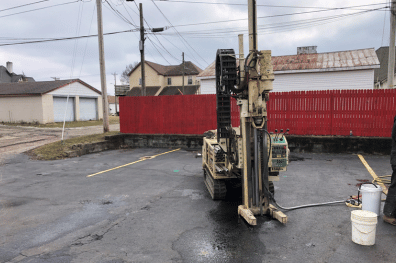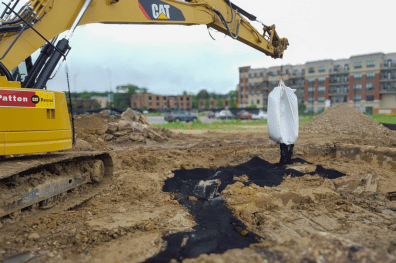The subsurface beneath a currently busy, multi-business structure is delineated as the source area for impacted groundwater. The soil matrix is predominantly silt. Remedial DPT injections targeted migrating plumes emerging from the source area. ORIN first conducted a pilot test around MW- 3 and MW-4, proving the effectiveness of the combined treatment chemistries. BAM was allocated into two thirds of the DPT injection locations in a grid like pattern.
The remaining one third injection locations received ABC+. Non-detectable levels of PCE were measured in MW-4 with no rebounding. ORIN later proceeded with full scale remedial activities around several additional target wells of the plume areas and a polish around MW-3. These results are amalgamated below.
The Challenge
The site presented complex operational requirements:
- Active multi-business facility
- PCE-contaminated groundwater
- Source area beneath structure
- Migrating plumes
- Silty soil matrix
- Business continuity needs
The Solution: Phased Treatment Approach
The team implemented a strategic three-phase process:
- Pilot Testing Phase:
- Initial treatment around MW-3 and MW-4
- Technology effectiveness validation
- Treatment protocol optimization
- Success criteria establishment
- Full-Scale Implementation:
- Strategic grid pattern design
- BAM deployment (2/3 of points)
- ABC+ integration (1/3 of points)
- DPT injection methodology
- Plume area targeting
- Polish Treatment:
- Additional MW-3 area treatment
- Targeted optimization
- Performance verification
Impressive Results
The treatment achieved multiple objectives:
- 92% total PCE reduction site-wide
- Non-detect levels in MW-4
- No contaminant rebound
- Sustained treatment effectiveness
- Maintained business operations
Key Success Factors
Several elements contributed to project success:
- Comprehensive pilot testing
- Strategic technology combination
- Optimal injection point distribution
- Phased implementation approach
- Continuous monitoring program
Innovation Highlights
The project demonstrated several advantages:
- Effective under active businesses
- Successful plume management
- Strategic treatment distribution
- Minimal operation disruption
- Sustainable remediation
Practical Applications
This approach provides solutions for:
- Active facility remediation
- PCE plume treatment
- Business-sensitive projects
- Source area management
- Complex site logistics
Business Impact
The successful implementation:
- Maintained normal operations
- Protected business interests
- Achieved environmental goals
- Demonstrated operational compatibility
- Provided long-term solution
This case study shows how strategic remediation planning can achieve environmental goals while protecting business interests.



